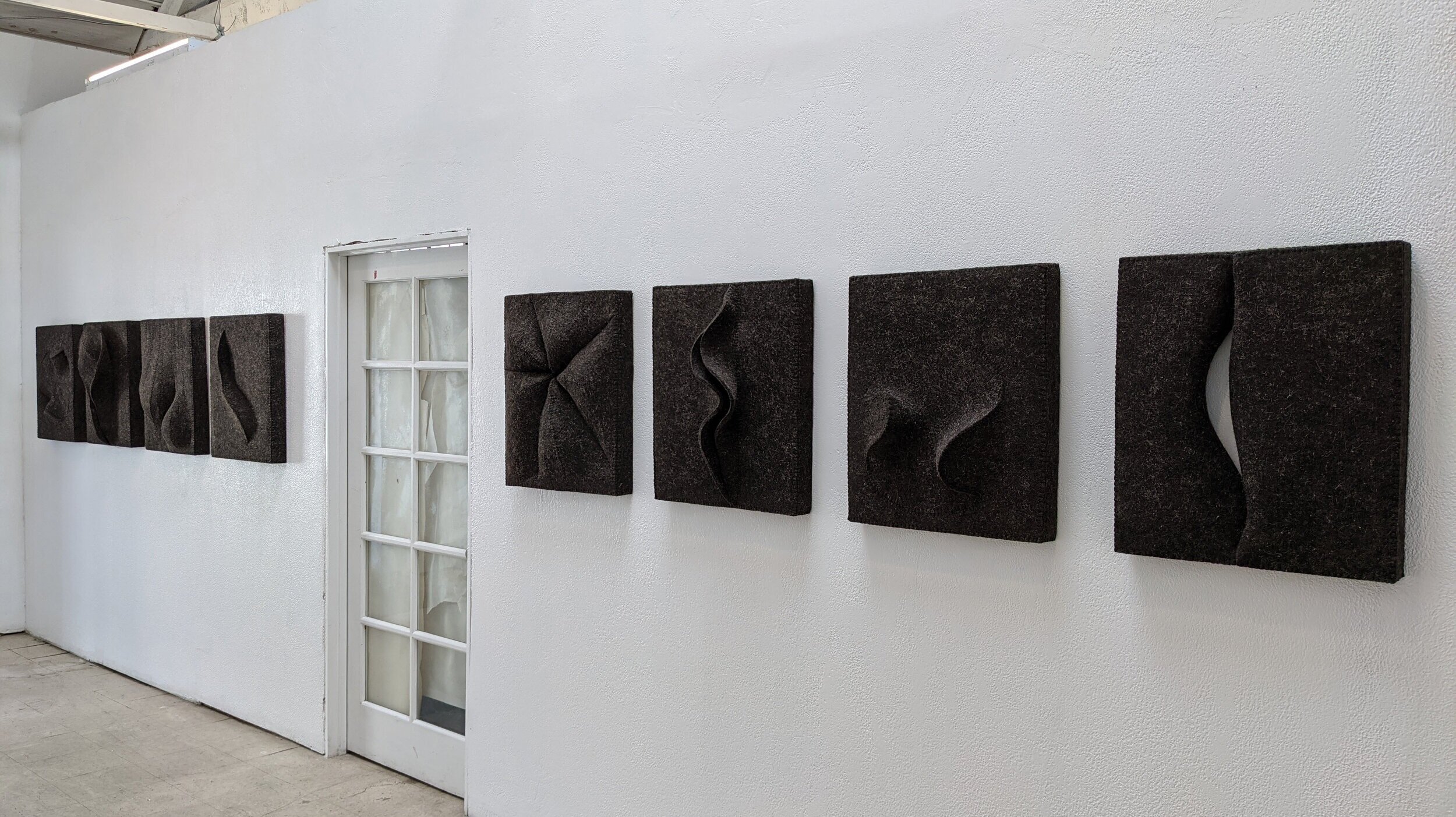What does it MEAN? Stitched Industrial Felt Wall Sculptures
I recently (finally) posted images of some new pieces I’ve been working on over the last year and a half, in between other smaller projects (eggshell wall sculptures), and longer-term projects (my video workshop). These ones are stitched industrial felt panels in which I’ve cut and stitched together ostensibly flat felt pieces to create forms that push out into three dimensions. The dark grey industrial felt is hand-sewn using suture-like black waxed linen thread; to give them the depth they need (some of the forms project back inwards) I mounted them over deep stretcher bars. Light barely reflects off the fibrous textured surfaces; when hanging on the wall as designed the range from dark to light across each piece is subtle and changes with the ambient light. Curves abound, both in the outlines of the pieces joined together and the resulting forms. These sculptures have lived quietly in the background of my studio over the months as I’ve gradually added to their number, often in a brief flurry of activity. They’ve been fairly private until now.
I hung them in a line in the hallway outside my studio in anticipation of finally opening up to invite visitors into the space once again. Somehow, hanging them together against a clean white wall finally made them look complete. What seemed too subtle now appears sublime and sure.
My relationship with the things I make goes through different phases, especially when I’m reaching in different directions than before. These wall panel pieces have been unnamed as a group or individually thus far; the making has been the focus for me, not the naming and presenting and reception. Today, though, someone asked me ‘What do you want these artworks to say?” and it set me back. I can sometimes forget that there are starkly different realities coexisting when it comes to artmaking and art consuming. I’m so deeply engaged in the making side of it, and in my practice I generally don’t go into it with a message I’m seeking to convey. I don’t need the artworks to say anything; they are more like the tangible, visible, tactile results of investigation and play. I don’t have a roadmap I’m following to get to a particular destination; I’m paying attention on the journey and I am willing to go down side roads that seem promising.
And then I’m reminded that it’s part of my job to help people make sense of what they’re seeing, give them an entry point, an answer to the ‘why,’ a meaning. We humans are hungry for meaning, and we’re willing to make it up if there’s an absence of it. But meaning differs from person to person, and that’s one thing I value about the abstract nature of the forms I create. My panel sculptures don’t present a narrative. The viewer comes to them from their own lifetime of experiences and sees and feels things (or doesn’t ) as a result.
From my end of the experience I can say that I've been challenging myself to work out the puzzles of how to make flat felt move into three dimensions, and found that it's entirely dependent on the edges that are joined together- how, where, at what angle and curve. It feels like an intellectual, physical, and creative triumph to make the humble, coarse industrial felt pieces come together to occasionally 'sing.' The search, the process, the making is endlessly engaging for me, and sometimes it results in forms that please me in the simple fact of their physical existence.
Viewers whose sensibilities resonate with mine tend to use words like ‘sensuous,’ ‘comforting,’ ‘satisfying,’ ‘beautiful,’ ‘body-like,’ ‘mysterious,’ and ‘mesmerizing.’ Others label them as ‘disturbing,’ ‘physical,’ ‘raw,’ ‘powerful',’ and ‘visceral.’ Which also resonate with me. Which is a long-winded way for me to explain that I don’t have something I want these artworks to say, but I know what I needed them to be in the world when I made them and now: solid, elegant and sturdy in defiance of their humble materiality; disarmingly simple, as complex forms so often are.
I keep coming back to curves: the ‘flat’ curves that make the ‘dimensional’ curves possible and visible. The curved lines I’ve cut into flat pieces of felt and stitched together fundamentally change the appearance and the behavior of the material. ‘Curve Compositions’ seem like an apt way to pin down the body of work, since I have to call them something. ‘Curve Compositions’ acknowledges my experience as the maker and gives the viewer an entry point; the word ‘curves’ fits both the physical and conceptual forms. Looking at them now, I respond with simple satisfaction to their sinuous planes on one level, but also appreciate the evidence of what brought about those shapes— the stitched seams suggest some of the thinking and intention behind the finished work. What do you get out of these? See more images here.

